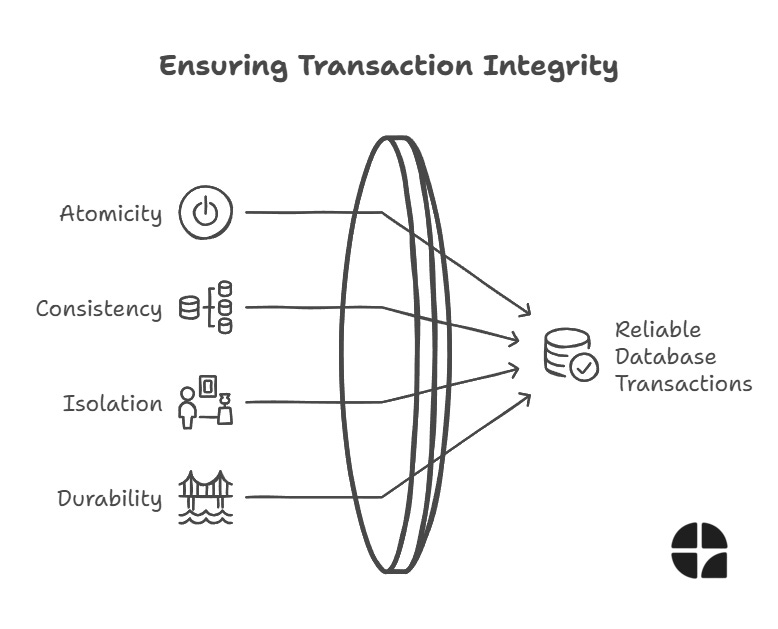Introduction
Imagine you're building the next big e-commerce platform. A customer places an order, and your system needs to:
Deduct items from inventory
Process the payment
Generate an order confirmation
Send a notification to the warehouse
What happens if the payment succeeds but the inventory update fails? Or if your system crashes halfway through? These scenarios could leave your database in an inconsistent state, potentially causing lost sales or angry customers.
This is where ACID transactions come to the rescue. Let's dive deep into understanding what they are and why they're crucial for maintaining data integrity.
What are ACID Transactions?
ACID is an acronym that represents four critical properties that guarantee reliable database transactions:
Atomicity
Consistency
Isolation
Durability
Think of an ACID transaction like a space shuttle launch - it either succeeds completely or aborts safely. There's no "partial launch" scenario.
Let's explore each property in detail.
1. Atomicity: All or Nothing
What is Atomicity?
Atomicity ensures that a transaction is treated as a single, indivisible unit. Either all operations within the transaction succeed, or none of them do. There's no middle ground.
Real-world Example
Consider a bank transfer:
BEGIN TRANSACTION;
UPDATE accounts SET balance = balance - 1000 WHERE account_id = 'sender';
UPDATE accounts SET balance = balance + 1000 WHERE account_id = 'receiver';
COMMIT;If either update fails:
The entire transaction is rolled back
Both accounts return to their original state
No money is lost in limbo
Implementation Details
Databases typically implement atomicity through:
Write-Ahead Logging (WAL)
Records intended changes before making them
Enables recovery if system fails mid-transaction
Two-Phase Commit Protocol
Prepare Phase: Ensure all parts can complete
Commit Phase: Actually perform the changes
2. Consistency: Maintaining Valid States
What is Consistency?
Consistency ensures that a transaction brings the database from one valid state to another valid state, maintaining all predefined rules and constraints.
Example Scenario
Consider an inventory system with a rule: "Stock quantity cannot be negative"
BEGIN TRANSACTION;
-- Current stock: 5 units
UPDATE products
SET stock_quantity = stock_quantity - 10
WHERE product_id = 123;6COMMIT;This transaction would fail because:
It would result in -5 units
Violates the non-negative constraint
Database remains in previous valid state
Key Consistency Rules
Referential Integrity
Unique Constraints
Check Constraints
Custom Business Rules
3. Isolation: Concurrent Transaction Handling
What is Isolation?
Isolation ensures that concurrent transactions execute as if they were running sequentially, preventing interference between them.
Isolation Levels
Read Uncommitted (Lowest)
Can read uncommitted changes
Prone to dirty reads
Read Committed
Only reads committed data
Prevents dirty reads
Repeatable Read
Ensures consistent reads
Prevents non-repeatable reads
Serializable (Highest)
Complete isolation
Highest consistency, lowest concurrency
Common Isolation Problems
Dirty Reads
-- Transaction 1
BEGIN;
UPDATE accounts SET balance = 1000;
-- Not yet committed
-- Transaction 2
SELECT balance FROM accounts;
-- Reads uncommitted value (dirty read)Non-repeatable Reads
-- Transaction 1
BEGIN;
SELECT balance FROM accounts; -- Returns 1000
-- Transaction 2
UPDATE accounts SET balance = 2000;
COMMIT;
-- Transaction 1
SELECT balance FROM accounts; -- Returns 2000 (different result)4. Durability: Permanent Changes
What is Durability?
Durability guarantees that once a transaction is committed, it remains permanent even in the event of:
System crashes
Power failures
Hardware failures
Implementation Techniques
Write-Ahead Logging
1. Record changes in log
2. Flush log to persistent storage
3. Apply changes to database
4. Mark transaction as committedReplication
Maintain copies across multiple servers
Ensure data survives single-point failures
Best Practices for Working with ACID Transactions
Keep Transactions Short
-- Good
BEGIN;
UPDATE users SET status = 'active';
UPDATE audit_log SET last_login = CURRENT_TIMESTAMP;
COMMIT;
-- Bad (too many operations)
BEGIN;
-- Multiple updates
-- Complex calculations
-- External API calls
-- File operations
COMMIT;Handle Errors Properly
try:
begin_transaction()
# ... perform operations
commit_transaction()
except DatabaseError:
rollback_transaction()
handle_error()Choose Appropriate Isolation Levels
-- For reading reference data
SET TRANSACTION ISOLATION LEVEL READ COMMITTED;
-- For financial transactions
SET TRANSACTION ISOLATION LEVEL SERIALIZABLE;Performance Considerations
Transaction Overhead
Each transaction requires additional processing
Logging mechanisms add I/O overhead
Higher isolation levels may reduce concurrency
Optimization Strategies
-- Group related operations
BEGIN;
INSERT INTO orders (...)
INSERT INTO order_items (...)
UPDATE inventory (...)
COMMIT;
-- Instead of separate transactions for eachCommon Pitfalls to Avoid
Transaction Scope Too Large
Not Handling Deadlocks
Inappropriate Isolation Levels
Missing Error Handling
Conclusion
ACID transactions are fundamental to maintaining data integrity in database systems. Understanding and properly implementing them is crucial for building reliable applications.
Key Takeaways:
Atomicity ensures all-or-nothing execution
Consistency maintains database rules
Isolation handles concurrent access
Durability guarantees persistence
Call to Action
How do you handle transactions in your applications? Share your experiences and best practices in the comments below.
Want to learn more about database design and optimization? Subscribe to our newsletter for weekly in-depth technical articles.


